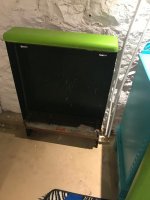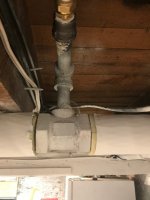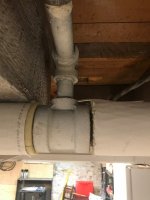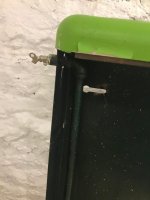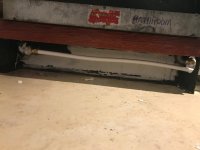I was asking about just the basement, not the whole house, since that's where you're adding the convectors.
Assuming the an 8" wall thickness the R-value of the brick is about R1.5, the interior + exterior air films add another ~R1 for R2.5 "whole wall", or a U-factor of about U0.4 (= 0.4 BTU/hr per degree-F difference per square foot of brick wall area.) If it's a 15" thick rubble foundation it'll be about U0.3.
To put a none-too accurate (but better than a WAG) number on the losses of the below grade wall & basement floor I'll run the numbers as if it were 4' above above-grade and no losses to the ground. I'll also assume 1' of brick wall exposed by open floor joists, and a rectangular 30' x 50' footprint (=160 foot perimeter.)
Basement windows are typically 3-4 square feet. I'll also assume no exterior doors to the basement. and 16 square feet of window.
The 99% outside design temp for Peterborough ON is -23C/-9F and I'll assume a basement temperature of +15C/+59F, for a temperature difference of 28C/68F.
Brick wall basement losses:
U0.4 x (1' x 160') x 68F= 4352 BTU/hr
Foundation wall area (with fudge factor for the rest) is 4' x 160' , less 16' of window area = 624 square feet.
Foundation wall (+ fudge) is then:
U0.3 x 624' x 68F= 12,730 BTU/hr
Assuming the basement windows are single-pane (no storm window) they run about U1. Basement windows are typically 3-4 square feet.
Window losses:
U1 x 16' x 69F= 1104 BTU/hr (If double-paned or storm windows that drops to about 500 BTU/hr)
Add it up and you're at
18,366 BTU/hr (ignoring infiltration for now.)
That's a heluva a lot less than 269,588 BTU/hr, eh?

(Does your boiler even have 270K of burner output?)
If you installed " of closed cell foam on the foundation wall & brick right up to the subfloor the U-factor of the U-factor of both the brick & rubble wall falls to ~U0.077. The combined brick & wall area is 784', and the losses would then be:
U0.077 x 784' x 68F = 4105 BTU/hr + window losses of 1104 BTU/hr comes to 5208 BTU/hr + infiltration losses.
Assuming 9' from the slab to the subfloor and 1500 square feet you're looking at 1350 cubic feet. Assuming reasonbly tight window & wall it's reasonable to assume there is no more than 0.25 air exchanges per hour of outdoor air infiltration, so that's (1350/4=) 338 cubic feet per hour. The specific heat of air by volume is about 0.018 BTU per cubic foot per degree F, so your infiltration losses would be about:
0.018 x 338 cubic feet/hr x 68F = 414 BTU/hr....
... bringing the total up to
5622 BTU/hr for an insulated basement. If your windows leak tons of air the infiltration losses could be 5x or more higher than that, especially if your top floor ceiling is leaky too (since the air leaks at the bottom & top of the house add up to the greatest amount of stack-effect drive.)
It would only take 0-1 convectors that size to keep the basement above 15C if it's insulated, since you have the distribution losses of the fat loop pipe with ~R2 insulation on them, and the standby / jacket losses of what's probably a beastly sized boiler in the basement.
Uninsulated it could conceivably add up to 3-5 of those 2' x 2' x 5" convectors. To get a better handle on their output, measure the actual depth & height of the fins, and the total width of the cabinet, as well as the high-limit temperature of your boiler, and your actual targeted indoor temperature for the basement.


